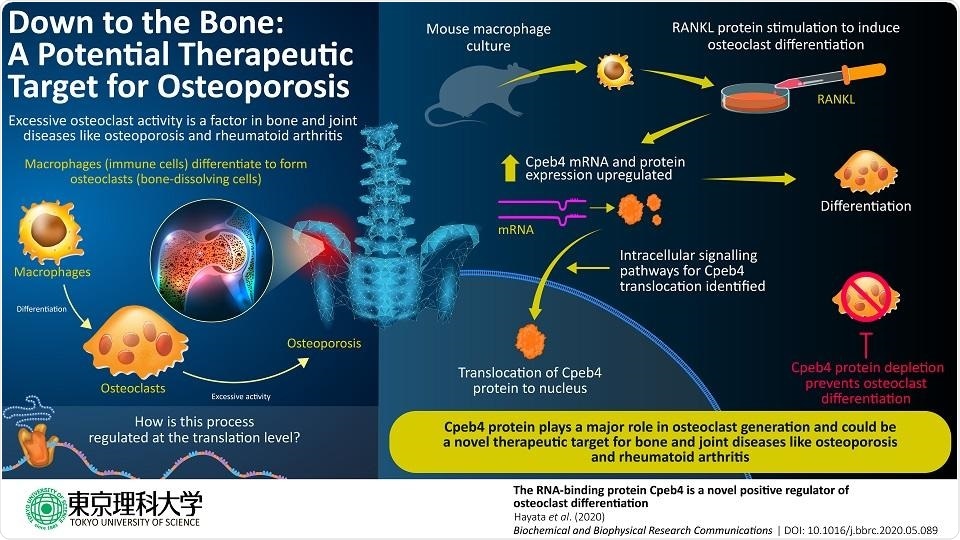Osteoclasts are bone-dissolving cells that are extracted from a type of immune cell referred to as macrophages. These cells are required for the renewal and maintenance of bones. However, the intracellular mechanisms by which macrophages change into osteoclasts are yet to be completely understood.

Role of the protein Cpeb4 in the generation of cells critical to bone maintenance. Image Credit: Tokyo University of Science.
Scientists at the Tokyo University of Science have now revealed the role of a protein known as Cpeb4 involved in this process. Their outcomes indicate promising therapeutic targets for osteoporosis and arthritis, both of which are bone and joint diseases.
Rheumatoid arthritis and osteoporosis are also chronic joint diseases that affect millions of people across the world, specifically the elderly population, impacting their quality of life. A significant factor in both of these diseases is the extreme activity of bone-dissolving cells known as osteoclasts.
Differentiation from a specific type of immune cell, known as macrophage, results in the formation of osteoclasts, which then acquire their unique role to maintain bones and joints, that is, disintegrating bone tissues to enable osteoblasts, another cell type, to repair and remodel the skeletal system.
Generally, a couple of intracellular processes are involved in this differentiation: first, transcription, in which a messenger RNA, or mRNA, is formed from the genetic data in DNA, and then, translation, in which the genetic information in the mRNA is decoded to create proteins that carry out specific functions in the cell.
Ever since the discovery of the role played by a specific protein, known as RANKL, in the formation of osteoclasts, researchers have solved a significant part of the mystery regarding which types of cell signaling routes and transcription networks control the generation of osteoclasts. Despite this, the post-transcription cellular processes involved continue to be elusive.
Researchers at Tokyo University of Science in Japan have now revealed the function of a protein, referred to as Cpeb4, in this complicated process. The study has been published in the Biochemical and Biophysical Research Communications journal.
Belonging to the “cytoplasmic polyadenylation element binding (CPEB)” class of proteins, Cpeb4 binds to RNA and controls translational activation and repression and also the “alternative splicing” mechanisms that create protein variants.
CPEB proteins are implicated in various biological processes and diseases, such as autism, cancer, and red blood cell differentiation. However, their functions in osteoclast differentiation are not clearly known. Therefore, we conducted a series of experiments to characterize a protein from this family, Cpeb4, using cell cultures of mouse macrophages.”
Dr Tadayoshi Hayata, Study Lead, Tokyo University of Science
Numerous cell culture experiments were performed in which mouse macrophages were activated with the RANKL protein to trigger the differentiation of osteoclasts, and this was followed by monitoring the evolution of the cultures.
The researchers initially found that the expression of the Cpeb4 protein, and thus the amount of the Cpeb4 protein, increased during the differentiation of osteoclasts. The scientists then observed the changes in the location of the Cpeb4 protein inside the cells through immunofluorescence microscopy.
They observed that Cpeb4 shifts from the cytoplasm into the nuclei while presenting certain shapes (osteoclasts tend to combine together and form cells with numerous nuclei). This shows that the function of Cpeb4 linked to the differentiation of osteoclasts is probably performed within the nuclei.
To find out how the stimulation of the RANKL protein results in Cpeb4 relocalization, the researchers selectively “inhibited” or repressed a few of the proteins that become involved “downstream” in the intracellular signaling routes induced by the stimulation.
The researchers eventually discovered two routes as required for the process. However, additional experiments will be needed to completely learn the sequence of events that occur and all the proteins involved.
Dr. Hayata with his research team finally showed that the Cpeb4 protein is definitely required for the formation of osteoclasts using macrophage cultures in which the Cpeb4 protein was actively depleted. The cells in these cultures did not experience any additional differentiation to become osteoclasts.
When combined together, the outcomes may pave the way to interpret the cellular mechanisms involved in the formation of osteoclasts.
Our study sheds light on the important role of the RNA-binding protein Cpeb4 as a positive ‘influencer’ of osteoclast differentiation. This gives us a better understanding of the pathological conditions of bone and joint diseases and may contribute to the development of therapeutic strategies for major diseases like osteoporosis and rheumatoid arthritis.”
Dr Tadayoshi Hayata, Study Lead, Tokyo University of Science
It is hoped that a better understanding of the generation of osteoclasts enabled by this research will eventually translate into a better quality of life for individuals living with painful bone and joint diseases.
Source:
Journal reference:
Arasaki, Y., et al. (2020) The RNA-binding protein Cpeb4 is a novel positive regulator of osteoclast differentiation. Biochemical and Biophysical Research Communications. doi.org/10.1016/j.bbrc.2020.05.089.